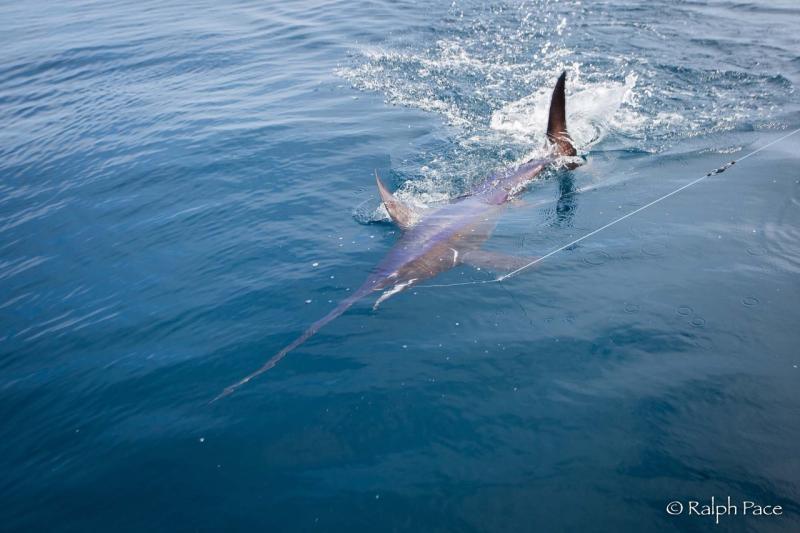
New West Coast Fishery increases access for U.S. Vessels to Swordfish
by NOAA Fisheries 14 May 2023 15:25 UTC

North Pacific Swordfish © Ralph Pace
A new West Coast fishery will take advantage of the deep-diving habits of swordfish to reduce the risk of catching other species. NOAA Fisheries has adopted final regulations for this new fishery under an amendment to the federal Fishery Management Plan for Highly Migratory Species.
The final regulations authorize a deep-set buoy gear fishery for swordfish, one of the most lucrative species on the West Coast. Fishermen have previously targeted swordfish mainly with drift gillnets, but recent federal legislation will phase those out in 5 years. Without other alternatives, only a small harpoon fishery remains to pursue swordfish, despite strong consumer demand and a healthy U.S. West Coast stock.
Commercial swordfish landings on the West Coast peaked in the 1980s at more than 7 million pounds worth close to $13 million annually, according to NOAA Fisheries statistics. Since then, increasing restrictions on gillnet fishing off the West Coast have reduced landings. In 2021, they were only 300,000 pounds worth about $1.5 million in 2021.
The Hawaii-based longline fishery that catches swordfish outside West Coast U.S. federal waters took over high-value markets such as restaurants and seafood counters. Deep-set buoy gear provides a new opportunity for West Coast vessels to pursue swordfish using fishing lines hanging deep underwater where few species other than swordfish venture.
"We want options for the fleet to fish for our healthy West Coast swordfish stock at a time when most of the swordfish we can buy in the store comes from abroad," said Ryan Wulff, Assistant Regional Administrator for Sustainable Fisheries in NOAA Fisheries West Coast Region. "We all benefit from greater domestic production, because we know the fish is caught safely and sustainably, consumers get more choices, and our local communities benefit."
Test Fishery Trials Started in 2011
Deep-set buoy gear trials began with experimental research by the Pflegler Institute of Environmental Research in 2011. In 2015, NOAA Fisheries began issuing experimental permits for deep-set buoy gear to test the method of fishing for swordfish off the West Coast. The trial was recommended by the Pacific Fishery Management Council. It showed that the new gear type may be productive for West Coast fishermen, and minimize impacts to protected marine species.
Deep-set buoy gear is the first new commercial gear introduced since the 2004 adoption of the West Coast Fisheries Management Plan for highly migratory species such as swordfish.
The new gear was recommended by the Pacific Fishery Management Council and assessed by NOAA Fisheries. A final rule authorizing the gear published on May 8, 2023. Up to 300 limited entry permits may be issued to fish with the gear in the Southern California Bight. They will be phased in over a 12-year period. Deep-set buoy gear will also be allowed in federal waters off Northern California and Oregon for fishermen authorized to catch highly migratory species.
The gear will not be authorized off Washington, as recommended by the Pacific Fishery Management Council.
Targeting Swordfish Deep
Deep-set buoy gear employs heavy weights to quickly sink baited hooks to between 800 and 1,200 feet, where water is very cold and low in oxygen. Tagging studies have shown that swordfish are one of the few species that can withstand those conditions for long periods.
"Swordfish have evolved the capacity to feed at great depth during the day, tolerating harsh environmental conditions for prolonged periods," said Chugey Sepulveda, research director at Pflegler Institute of Environmental Research, who led much of the tagging and gear development research. "While they are at depth, they are only accompanied by a few other species, which provides a good opportunity for selective targeting."
Deep-set buoy gear is so selective that swordfish comprise upwards of 95 percent of the fish caught with the gear. Deep-set buoy gear catch can also include a small number of bigeye thresher sharks, which fishermen generally release back to the ocean alive.
NOAA Fisheries projects that the gear could catch between 3,752 and 5,400 swordfish each year once all the available permits are issued. That would be well within the capacity of the Western and Central North Pacific Ocean swordfish stock, the source of swordfish caught off the West Coast, according to stock estimates.
Swordfish prices can vary widely. Some fishermen have questioned whether they can catch enough swordfish with deep-set buoy gear for the method to be profitable in the long term. Prices, catch amounts, and the extent to which commercial fishing vessels use the new gear will determine its economic success, according to NOAA Fisheries' evaluation.
The West Coast Region permit office has more information on applying for the new deep-set buoy gear limited entry permit. You can also contact them at .